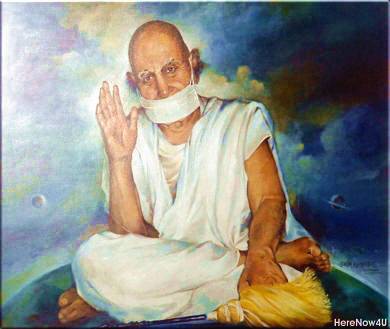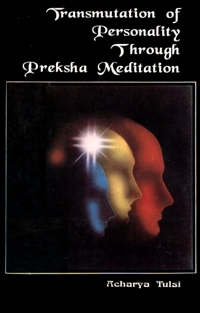
Chakshus Kendra, pupil-centred, doubtless the bridge of peace,
For natural concentration, filling the body and mind with joy!
The sixth centre in the ear, for alert recognition;
Increase in wakefulness is its great contribution!
And whoever concentrates on the tip of the nose, the Centre of Vitality
Is filled with energy, his whole being wreathed in smiles!
Brahma Kendra on the tip of the tongue, for continuous meditation;
Lust subsides of itself; the inward voyage goes on without a pause!
What is the function of Chakshus Kendra, the Centre of Vision? Does it clarify our vision or affect the waves of passion within? While meditating on this centre, should the eyes be kept open or closed?
The eye sees everything but we never centre our attention on the eye. To see and recognise it we need an inner eye, which can be opened through meditation. The eye is intimately connected with the brain. It is an important medium for the diffusion of vital electricity. When we close the eye and meditate upon it, we save a considerable amount of electricity, which could be utilized for developing our will power or concentration.
Chakshus Kendra, the Centre of Vision, may also be called the window of the brain. Its function is to refine the emotions and develop mental peace. As long as the psychic centre itself remains defiled, it cannot influence the current of emotion. From this point of view, meditation on Chakshus Kendra (the Centre of Vision) is bound to purify one's vision. If one's vision is pure, one's approach would also be clear. The man endowed with a clear approach is neither suspicious of another, nor does he conduct himself in a way as to invite suspicion upon himself. With the maturing of meditation on Chakshus Kendra, the cerebral cortex also becomes activated, because this centre is also connected with the Centre of Knowledge.
Whether the eyes are kept open or closed or half open or unwinking would depend upon the temperament of the meditator. The position in which there is the least intrusion of thought during meditation and which is conducive to the increase of concentration will prove useful. However, half open eyes are generally deemed best for meditation. When one wishes to close the eyes, one should do so very softly.
Is there a psychic centre meditation on which increases wakefulness and strengthens self-control? In the beginning, the moment one sits for meditation, one begins to doze. What psychic centre must be awakened to be free from sleep?
The Centre of Alertness increases wakefulness and delivers one from the onslaught of sleep. This centre is located in the ears. The sensations of consciousness are pretty clear here. A little concentration on these helps to remove sloth. Sleep evaporates and inner awareness grows.
In our country, women often get their ears pierced. Why? To wear ornaments? Superficial thinking may derive such a conclusion. But if we go into it deeply we shall find that our ancestors started this tradition of ear piercing after a great deal of thought. Whether this secret is known today or not, the physiologists have established on the basis of experiments that the upper and lower parts of the ear are very important from many points of view.
The monks of the Nath sect get their ears pierced. They get very big holes made in their ears, and that is why they are called kanfat, which means ‘ having perforated ears'. Nowadays, people might go in for getting their ears perforated in blind imitation of a tradition, but originally this special exercise was performed to increase one's capacity for self-control.
According to the physiologists, the human ear and the sinews around are very important. A Russian scientist and a lady doctor of Hong Kong have freed many people from addiction to drinking and smoking by administering electric shocks on their ears. All this goes to establish that the ear is the centre of wakefulness and that is why it is called the Centre of Alertness.
During the practice of preksha dhyana, several people have achieved freedom from addiction to intoxicants and they have been able to give a new direction to their life. There are many unknown secrets about our body. The ancient masters sought them, and today's science is also engaged in their discovery. There is no room for doubt or non-belief here. If we come to know those secrets and make right use of them, we can derive great benefits.
When a boy is naughty, he is pulled by the ear. Repeated verbal instructions may fail to bring home to him something, which he immediately grasps the moment his ear is pulled. This practical example also makes it clear that the ear and the area adjacent to it and the temples constitute a very sensitive field. In ancient times, meditation was done on these, and in the system of preksha dhyana, too, this centre has been accorded due importance.
According to available references to the meditation posture of the great preceptors and other yogis, there was prevalent a tradition of meditating on the tip of the nose. Is there located a psychic centre there, too?
The ancient tradition of meditating on the tip of the nose has been long prevalent. Acharya Hem Chandra, describing the meditation-posture of Lord Mahavir, says:
0 Lord! The posture of your totally relaxed body in the lying-down position with unwinking eyes fixed on the tip of the nose is most remarkable! And it is not accessible to everyone.
The main reason for fixing the gaze on the tip of the nose is the existence there of vital energy. Although the vital energy abides in other parts of the body too, the front part of the nose is its principal centre. The moment consciousness is fixed there, the fundamental nerve is tensed and mulabandh materialises of itself. The tip of the nose is a typical point of consciousness. It is known as Prana Kendra, the Centre of Vitality. Many acharyas have advocated meditation on Prana Kendra, with articulation of ' Om' or of the aspirate. The centre there commands significance, along with the mantra. The nose-tip is the centre of vital electricity. Thus, the activation of this centre is very necessary for the invigoration of vital power. The vital power abiding in our body is all-important. Only a man endowed with vital power can do something. He, whose vital power languishes, can do nothing. A man devoid of vitality is sunk in despair and becomes frustrated. To remove despair and frustration, meditation on Prana Kendra, the Centre of Vitality, is very useful.
What psychic centre should be meditated upon to conquer lust? What other ways are open to a sadhak in this context?
Brahmcharya is connected with Brahma Kendra. Brahma means the soul. For self-remembering, meditation on this centre is a must. It is located on the tongue. The tongue is not concerned only with eating and speaking; it is also connected with sexual desire. Sexual craving has two end points--the tongue and the genitals. Only the sadhak who is capable of controlling these two sense organs can conquer lust.
Some people are of the opinion that the control of the senses is not necessary for meditation, that this control inevitably comes into being in the practice of meditation. From one angle, this idea may be all right. Yet every sadhak is not so capable as to properly use the energy released by meditation without practising self-control. In the absence of control, if the current of energy is turned in a contrary direction, the possibility of some great calamity occurring cannot be denied. Therefore, the control of the senses is also necessary. The man who has no control over his palate will find it difficult to be free from lust. If the electrical vibrations of the tongue are tranquil, the electrical vibrations of the genitals, too, will remain tranquil. Although all the senses are factors in the stimulation of the sex-centre, the tongue occupies the foremost place among them.
Whoever has written anything about Brahmcharya at whatever time, has also elaborated upon moderation in food. It is not a matter of some gross connection; rather the question pertains to the intimate relationship between the tongue and the genitals. Research was done on this inter relationship and its results have proved to be infallible from the point of view of sadhana. Through control over the senses, moderation in food, easy and regular life, and the practice of meditation, a man can conquer lust. He has also to take certain precautions from the practical point of view. Combined with all this, meditation on Brahma Kendra, is a sure means of realising Brahmcharya.
 Acharya Tulsi
Acharya Tulsi
